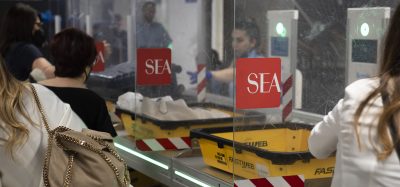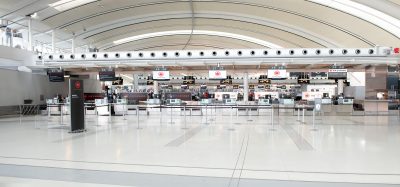Baggage handling system developments at Milan Malpensa: 1998-2008
- Like
- Digg
- Del
- Tumblr
- VKontakte
- Buffer
- Love This
- Odnoklassniki
- Meneame
- Blogger
- Amazon
- Yahoo Mail
- Gmail
- AOL
- Newsvine
- HackerNews
- Evernote
- MySpace
- Mail.ru
- Viadeo
- Line
- Comments
- Yummly
- SMS
- Viber
- Telegram
- Subscribe
- Skype
- Facebook Messenger
- Kakao
- LiveJournal
- Yammer
- Edgar
- Fintel
- Mix
- Instapaper
- Copy Link
Posted: 7 February 2009 | Stefano Dolci, Head of BHS Management, SEA – Milan Airports | No comments yet
From barcode to RFID through to XRay controls, BRS and software enhancements.
Malpensa is the one of the newest airports in Europe: it was opened on the 25th of October, 1998. Malpensa was planned as a ‘point to point’ airport and from the beginning was used as a ‘hub’ for Alitalia. This caused the necessity to partially redesign the airport. One of the key points for a hub is to handle transfer bags, so we needed relevant changes to the Baggage Handling System (BHS).
At the opening, the airport suffered from the fact that its BHS was not able to handle large quantities of transfer bags and for this reason a manual facility on the apron, dedicated to transfer bags, was put into service. The results were not satisfactory and Malpensa ranked low amongst the other European hubs for the number of mishandled bags. As the baggage system is the heart of an airport, it also caused a reduction in punctuality.
SEA Milan Airports, the owner and manager of the two milanese airports (Linate and Malpensa), decided to face the situation so as to offer its customers the best service. The main decision was to close the manual transfer facility and to handle all bags (local and transfer) on the same automated system.
System improvements
That decision obviously required improvements to the system, as a larger number of bags had to be handled by it. As a first step a new transfer area, with a capacity of 2400 bags/h, was realised and the manual facility was closed. Immediately some benefits became evident, i.e. handlers could work on one loading point only per flight, as all the bags were arriving on the same departure carousel.
At the beginning the functionality of the new transfer area was affected by a very poor reading rate. This was due to the quality of the barcodes and to the absence, for many flights, of the BSM, the message sent by the hub airlines which is needed to know the final baggage destination.
These problems required deep analysis to understand which airports where causing the problem and why they were not sending the proper message.
On the other hand, other system improvements were decided upon. Among these was the decision to enlarge the transfer area and increase the number of manual encoding stations (the positions where non-read baggage is sent to be manually encoded). The introduction, from 1 January 2003, of 100% XRay scanning added other difficulties, which we reacted to by installing a new HBS (Hold Baggage Screening) system, capable of screening more than 14,000 bags/h with a multilevel scanning system.
The modified BHS then required software enhancements to increase capacity, and automatise the use of back-ups, that until then were manual and needed a long activation time. The software enhancements allowed the system to automatically and instantaneously react to jams or faults, diverting baggage onto other routes so as to avoid stopping the flows. Software modifications were very important to increase the availability of the system and to allow our airport to reach a better position in the charts for mishandled bags.
Another problem to be solved was related to ‘early bags’, as a huge number of transfer passengers were leaving after many hours and their bags had to be stored somewhere, waiting for their flight. A new EBS (Early Baggage Storage) was installed in 2004, with a capacity of 1800 bags. An EBS stores a large amount of bags that are then released at the same time. To avoid peaks of request on the baggage handling system, it is necessary to accurately manage these flows with dedicated software tools. On the other hand, a lot of work was undertaken with the handling agents to improve the whole baggage process.
New systems
These improvements on the baggage system, and on the overall baggage process (better handler organisation and better quality of tags and messages), allowed Malpensa to continuosly reduce the mishandled rate, improving customer satisfaction and increasing its passenger traffic by more than 10% annually. The hub carrier continued to improve its operations, reducing transfer times and increasing volumes. This caused the necessity to further extend the BHS and to deal with short connecting bags. A new system, with new technology (trays), was then installed to double the capacity and to cope with traffic peaks (the peak request has in fact reached 7000 bags/h) in a better way.
This tray system, which handles bags in a more efficient and careful way, allowed the airport to reach first position in the rank for mishandled bags and to stabilise the entire baggage process. Even though the tray system has a greater speed (up to 5 m/sec.) and reduces the sorting time, the ‘big’ system was not yet able to provide the handling times needed for short connecting bags: hence the decision to install a dedicated system, able to handle short connecting bags (from loading to departure carousel, through security controls) in only three minutes. This system, which has dedicated in-feed lines, is also connected to the ‘normal’ transfer area, so bags with a reduced time (i.e for delay of the arriving aircraft) but not stored in a dedicated container, could be automatically identified and sent to the short connection system, allowing them to be embarked on the second leg of their journey.
In the end, the capacity of the BHS at Malpensa became of 10,500 bags/h with 4,500 transfer bags/h and 2,000 short bags/h. At this point we were most of the way there and results were satisfactory, but as you get nearer to the best level of service it is more and more difficult to increase it again and so you need the most advanced technologies to succeed, like BRS (Baggage Reconciliation System) and RFID (Radio Frequency Identification).
New technologies
In 2006, SEA decided to invest in new technologies to further improve baggage handling. An automated Baggage Reconciliation System (BRS) and a Radio Frequency Identification system (RFID) were planned.
The new Baggage Reconciliation System (BRS) was developed and supplied directly by SEA to all carriers operating at Malpensa. This system is primarily used to increase security (no bag on board without its owner) and substituted the old manual reconciliation which was carried out with the so called ‘bingo sheet’ (a sheet of paper where baggage tags were applied to identify the contents of a baggage container). Our BRS system also has many features to ease bag loading operations and to provide a better level of service. The introduction of this system has in fact dramatically reduced the mishandling rate and obviously increased passengers’ satisfaction.
On the other hand, the problems with the barcode reading rate and with the BSMs availability have not been completely solved and we decided to go with RFID.
RFID on baggage
Malpensa has been following RFID technology for many years and in 2008 has installed a complete RFID system on its BHS in Terminal 2. Malpensa is the first airport in Europe and the third in the world, after Las Vegas and Hong Kong, to use this technology for baggage sorting. The RFID system is available for all carriers and is capable of fully substituting the old barcode technology. The system uses passive tags and is fully respondent to IATA RP 1740 and Gen 2 standards. The RFID system in Malpensa, supplied by Lyngsoe Systems A/S, has 6 RFID reading points, 1 RFID writing point, 18 antennas and 4 readers. The BHS could now work in three different ways: barcode only (as before the RFID installation), RFID only, and RFID/barcode combined readings so as to achieve the highest reading rate. In a BHS the goal of RFID is to associate the reading with a physical bag. In order to start the tracking and sort the bag to its destination carousel differently from other applications, singulation and correct sequence are absolutely essential.
Malpensa is now using a new and powerful singulation algorithm, which closes the era of the ‘tunnel solution’ (where they try to read one bag at a time only) and enters the era of the ‘open cage solution’ (where multiple bags are read at the same time). In fact, as it is really difficult to limit the field created by the antennas, the choice was not to limit it at all and to use the readings from different bags to feed a new algorithm, which is in charge of creating the right bags sequence. The new singulation algorithm, which for the first time takes signal strength into account, allows us to eliminate curtains (thus solving problems caused by curtains to photocells) and to reach higher reading rates.
The reporting system records all the data necessary to evaluate the RFID reading rate and to compare it with the barcode reading rate. Each bag has a file in which, besides the readings and general information, there is a photo intended to help to identify the causes for any missed reading (metal bags, torn tags, etc.). The RFID system has performed 100% reading rate up to 1000 bags in a row in very challenging conditions (high throughput, ≈ 2000 bags/h). The overall value is > 99.8%.
Beyond the reading rate, RFID has another important advantage, as no BSM will be needed in the future when the cost of ‘large memory tags’ will decrease. Bag data could be stored in the RFID tag itself, reducing the number of ‘unknown’ bags on the system due to the lack of the message, thus avoiding manual encoding operations which cause an increase on sorting times and the risk of human errors. One of the main concerns obstructing the introduction of RFID from carriers is related to ‘transfer bags’, as it is, at present, impossible to have RFID tags from all the originating airports.
A solution to this problem has been identified by SEA using a blank RFID tag embedded in the normal baggage tag from the originating airport (where no technology is required, only the use of a RFID baggage tag roll for specific flights). When the bag reaches the ‘RFID airport’ the existing barcode scanners read the ten digits from the barcode and immediately, after a specific ‘RFID writing position’, write it on the RFID tag without stopping the bag. In this way, it is possible for the hub airport to have 100% RFID tags on the sorting area without the need to apply them.
From the airlines point of view, the adoption of RFID is not as advantageous as it is for the airports. The reduction of the mishandled rate (airlines first concern) is achievable more with a good baggage process and a good BRS than with RFID. RFID permits you to increase the reading rate, which obviously helps in sorting bags correctly and in time, but the ROI is more on the airport side than on the airlines. This is probably the reason why, till now, only airports (Las Vegas, Hong Kong, Milano) have chosen RFID and airlines are still in the pilot test phase.
Conclusions
The development of the initial baggage system has relied on hard work and new installations. New systems have increased the capacity, but an important step lay in the software enhancements. These changes bring, as a major result, the possibility to instantaneously divert flows in case of anomalies. BRS allowed us to better trace baggage and to identify problems during the entire process. In 2007, Malpensa was the 1st European hub for punctuality, with more than 80% of ‘on time’ departures, and one of the best hubs for mishandling rate.
When the system and the whole baggage process had reached a very good level, we decided to adopt RFID, considering it as a step towards the future and as the final improvement to top the chart. RFID in fact is giving us a higher reading rate, no need for the BSM in the future and the chance to have better tracking, as an RFID reading position costs less than a barcode one.
















